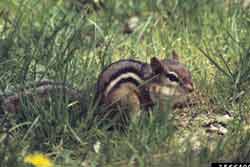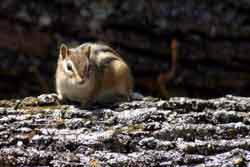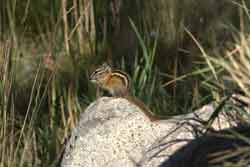Home → Pests → Other Critters → Chipmunk
Eastern Chipmunk—Tamias striatus
Chipmunks are mammals and omnivores. Their diet consists primarily of grains, nuts, berries, seeds, mushrooms, insects, and salamanders; they also prey on young birds and their eggs. A valuable forest inhabitant, chipmunks move seeds around for tree regeneration, and they are an important food source for birds and other mammals. The Eastern chipmunk typically inhabits mature woodlands and woodlot edges, but they are also found in and around suburban and rural homes.
Although chipmunks do not cause serious agricultural damage, they can be a nuisance in the garden where they eat flower bulbs, fruits, seeds, and seedlings. They also may cause structural damage by digging under patios, porch stairs, walls, or foundations.

Chipmunks are 8 to 10 inches long, including the tail, and weigh between 2 and 5 ounces. They are reddish brown with a single stripe down the center of its back and a whte stripe between 2 black strips down each side of its body.
Click on images to view full-size
Identification and Control Information
- Animal Damage Management: Chipmunks (PDF)—Purdue University Cooperative Extension
- Vermont Wildlife Fact Sheet: Eastern Chipmunk (PDF)—Vermont Fish & Wildlife
- Wildlife Damage Control: Chipmunks (PDF)—Penn State College of Agricultural Sciences Cooperative Extension
More Information
- Dealing with Nuisance Wildlife (PDF)—University of Maryland Cooperative Extension
[Photos, left to right: Alfred Viola, Northeastern University, Bugwood.org; Paul Bolstad, University of Minnesota, Bugwood.org; David Cappaert, Michigan State University, Bugwood.org]

